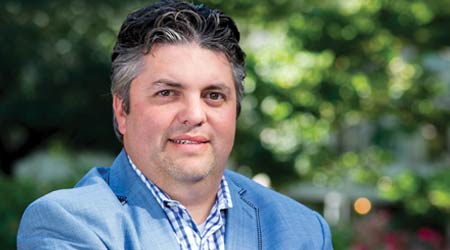 The Mayor of Rockefeller: Alex Kogan, associate vice president of plant operations and housing, leads a tight-knit facilities team in the service of science at The Rockefeller University.Photo: The Rockefeller University
The Mayor of Rockefeller: Alex Kogan, associate vice president of plant operations and housing, leads a tight-knit facilities team in the service of science at The Rockefeller University.Photo: The Rockefeller UniversityEffective Facilities Management Is Level-Headed Facilities Management
Kogan is unflappable and imminently approachable: Two factors that have brought him respect from his staff and success over his long career.
Leading from behind is one of those management catch phrases bandied about, but Kogan provides a real example that the concept is effective and meaningful when executed by a competent and generous leader. But on top of that, Kogan’s leadership is marked by a centered friendly openness. “He’s unflappable,” says O’Connor. “And that’s the kind of leader who gets the most out of those around him.”
Stepanchak agrees, saying in the 25 years he has known Kogan he’s never seen him respond to a crisis with anything other than a calm and steady presence. “I’ve never seen him get rattled,” he says.
This attitude helps Kogan diffuse the stress of situations, which allows them to be addressed more efficiently, whether it’s for a researcher in a lab or for a student’s spouse in an apartment. “He has this long title but I encapsulate it as Alex Kogan is the mayor of Rockefeller University,” says O’Connor. “By day, people are calling him about their scientific facilities and making sure everything’s smooth, and by night they’re calling about their housing issues. He leads by example, he’s available, he’s personable, he’s responsible. He just gets the job done. The only thing that I’ve been able to see that he hasn’t been able to fix is the slice in his golf swing.”
Perhaps the golf thing is because Kogan is a soccer guy. He was All-American in high school and played Division 1 in college. He credits his soccer career, and his role as team captain at both levels, with informing his approach to leadership. “Soccer was my life,” he says. “I always knew to get to a certain point what you had to put in. I was extremely committed, knowing if the hard work is put in the end result will always be there.”
When asked what he thinks about being called “unflappable” he says, “Calm and collected goes a long way. I don’t always know what the right answer is, but you have to give off some sense of leadership just so your staff says, ok, we’ve got to believe in this guy, we’ve got to follow this person.”
In addition to not being interested in drama, Kogan is also not interested in pointing fingers when a problem arises. His interest is in fixing the problem with a true solution, not a bandaid. Once the crisis is over, that’s the moment to go back and figure out what went wrong, but only for the purpose of making sure it doesn’t occur again. That is important anywhere, but critical at a research institution where a leak or a loss of power or other emergency could mean losing irreplaceable data and there’s no time to waste.

(The River Campus’ research facility stretches over almost three city blocks and features a window wall overlooking the river which fills the labs with natural light and views. Halkin Mason / Rafael Viñoly Architects)
Fixing the problem first is also a smart move from a customer-service perspective, he says. “I worked for many bosses who were very quick to CYA,” he says. “Sometimes if you just spend a little time to just try to fix it and try to get your customer satisfied, then you buy yourself a whole abundance of time to make sure it doesn’t happen again.”
That personal touch is important when responding to non-emergency situations as well. Though technology now enables a hot/cold call, for example, to be addressed remotely, Kogan still requires his team to physically visit the space, see what’s wrong for themselves, and then go back to the system to make the adjustment. “I like the face-to-face interaction,” says Kogan. “If there’s a problem, I want to be there. I think you buy a lot more time to respond if people know you’re working on it.”
Related Topics:
















